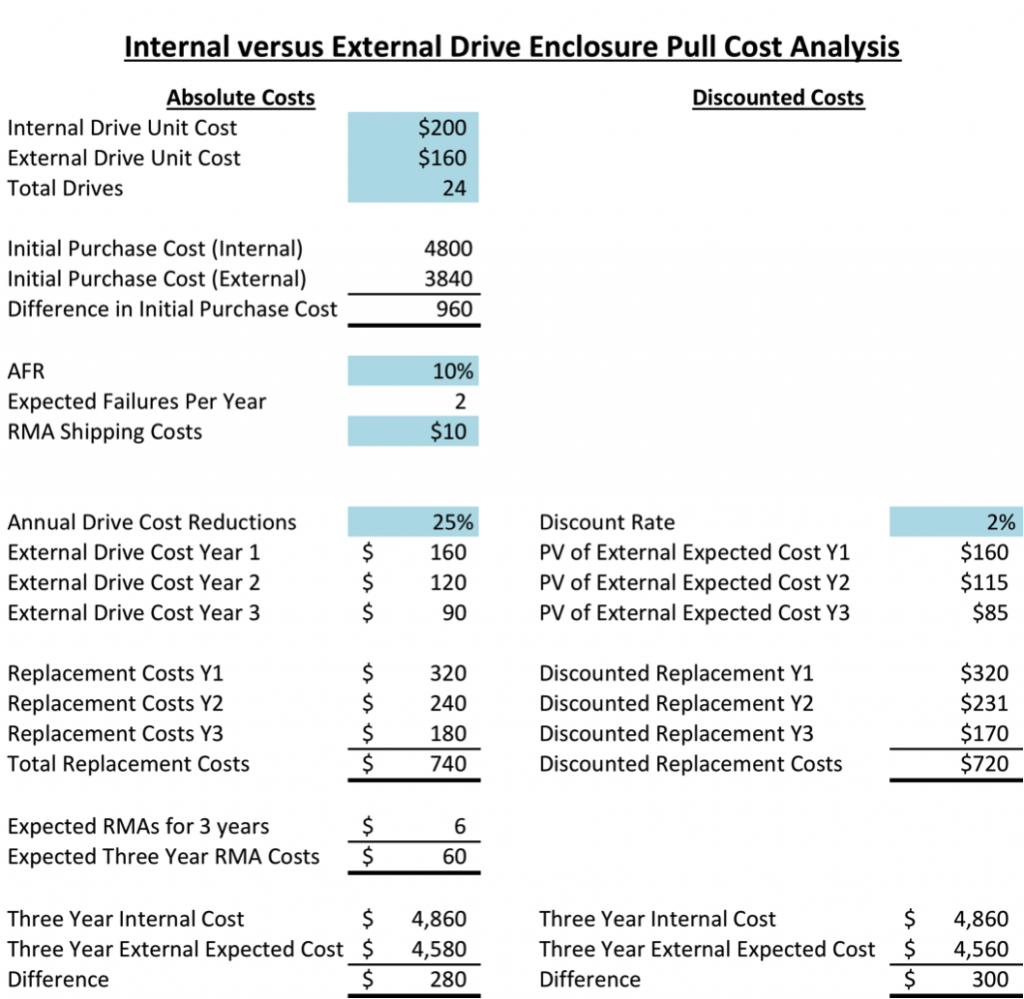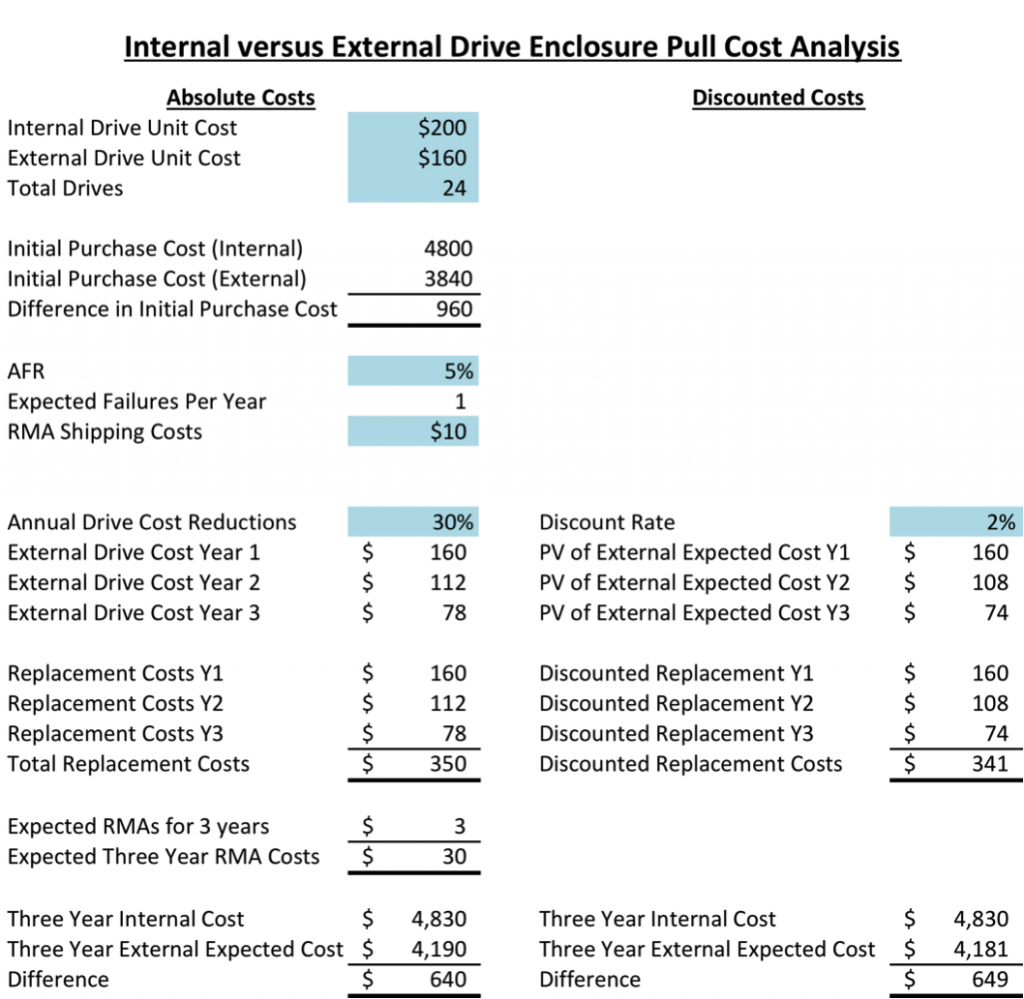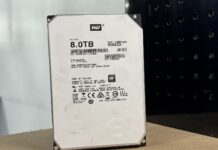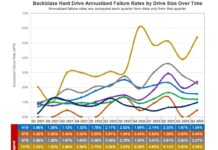Internal hard drives usually carry a manufacturer’s warranty, commonly three years. Personally, I believe that after three years, one wants to replace drives due to the fact that failures start to occur at a greater rate after three years. One other way to source internal drives for the average consumer is to purchase an external drive and to liberate it from the OEM external enclosure. Generally this means voiding any warranty provided for the drives by the manufacturer. The question is, can purchasing external drives and voiding warranties be less expensive than purchasing internal drives with warranties.
One interesting data point before this article continues, major OEMs (HP, Dell, Apple, and etc.) and storage firms (EMC and NetApp) purchase drives without warranties and receive discounted pricing.
The Test Subjects
This discussion came about after seeing that external 3TB drives were being advertised for $160 in Fry’s ads, while the internal 3TB drives were being advertised at $200. It is well known that one can extract drives from external enclosures so the question became is it worthwhile to purchase a more expensive drive with a warranty or a cheaper drive with no warranty.
[amazonshowcase_480912839ea613266d87f1bdb881252f]
Note: As of this writing (1 Feb 2011) the recent Fry’s deal was $159.99 for the external Hitachi 3TB USB2.0 drives (Amazon still has them for $169.99 as a standard price) and the 3TB Hitachi internal drives for $199.99. Deals come and go but there is still a clear price delta. For those wondering, the drive inside the external USB 2.0 enclosure is a 3TB 7,200rpm drive also.
Warranty Period
The first assumption is around hard drive warranty periods. Some hard drives like the Hitachi Ultrastars and Western Digital Raid Edition Drives have five year warranties. For this article, a three year warranty and service life will be assumed which matches the common warranty term for most consumer and prosumer drives that are common in home and small business storage servers.
Another assumption is that by removing a hard drive from the external enclosure will void the warranty for the hard drive. Manufacturers like Seagate, Western Digital, and Hitachi which package their internal drives in external enclosures know that a given drive was sold as an OEM drive (manufacturer warranty applicable), OEM drive (no manufacturer warranty applicable), Retail Internal Drive (manufacturer warranty applicable), Retail External Drive (no manufacturer warranty available on the internal drive but available on the full external unit), and a few other iterations. For those thinking that one can extract the internal drive from an external enclosure, then re-install a failed drive for warranty replacement be warned, do not bother. The external enclosures generally have tamper seals that prevent users from passing off opened enclosures as still sealed. My advice, do not try this and assume that extracting a drive will result in loss of warranty privileges for everything.
Drive Costs
One very important factor in determining the cost of the warranty is the cost to replace drives that fail. A very simple model would assume constant drive costs, however this is not reality. Hard drives cost less each year at a given capacity. Conservatively I am currently using a 25% annual cost reduction per year. So a $100 drive replaced in year 2 (or 1 for the programmers out there), will be $100 * (1.00 – 25%) = $75. Looking at 2TB drives, the annual price decreases have exceeded 25%. On the other end of the spectrum, smaller capacity drives do tend to fall in prices by lower amounts each year because there are fixed costs for licensing, physical casings, controllers and etc. that tend to create an effective cost floor for hard drives.
Furthermore, drive purchases occur in different years and therefore must be discounted. I assumed that the discount occurred at the end of the year so that the discount did not apply in year 1 (or 0 for the programmers).
RMA Shipping Costs
One thing often forgotten is the fact that there are costs involved in the RMA process. I average about $9 to ship drives back to manufacturers for RMA purposes. Sometimes there are packaging costs, or additional costs to drive to a shipping location which made me round my RMA shipping costs up to $10 per RMA. Without the ability to RMA, one will not incur these costs. For those wondering, I did not discount the $10 over time to account for the fact that shipping costs either stay constant or raise over time.
Annual Failure Rate (AFR) Assumptions
Without manufacturer data, this is probably more of an art than a fiction. Most figures of real-life drive populations that I have seen range from 4% – 8% AFR, and there is a bias towards drive failing in the first few months versus in the second year for example due to the bathtub curve that illustrates hard drive failures. I used ten percent in this model which biases results towards purchasing drives with warranties. Feel free to play with this one.
Discount Rate
For the example below I chose a 2% discount rate which basically allows one to calculate the present value of some future expenditure. A basic example of this is that if one saves $100 today, and gets 2% annual interest, then in one year the $100 will have grown to $102. In reverse, to have $100 in one year means that one would need just over $98 today invested at 2% interest. I used 2% here to be very conservative as most people use higher rates. With the short term (this is a three year period) a high discount rate would skew the numbers strongly in favor of purchasing external drives at lower costs.
Other Considerations
One important consideration is that there is a potential change in reliability due to extracting the drives from enclosures. The drives were first installed in enclosures, and then the extraction process does add additional strain to the drives. While heads may stay parked and locked, it is possible that a latent manufacturing defect, such as a dislodging of a microscopic piece of metal is introduced as the result of the extraction process. I have no way of modeling this and frankly, results will vary with the model of external drive and the person doing the disassembly.
The Spreadsheet Output
Here is what the Excel sheet looks like, I will see if I can get someone to code this into a WordPress format to make this easy to use in the near future. If you are an expert WordPress programmer, and want to do this, please let me know.
As one can see below, in the 24 drive, 8% AFR scenario using a $200 internal cost and $160 external cost (using 1 Feb 2011 prices for the Hitachi 3TB drives), and a 25% annual price reduction for drives of the same capacity one yields a $280 benefit over three years by purchasing the external versions. Using a conservative 2% discount this is $300.

Going a bit less conservative and assuming a more “standard” 5% AFR, the same drive costs and a 30% annual price reduction, that difference jumps to $640 and $649 over three years.

Again, hopefully I can get someone to code this simple spreadsheet as it is probably useful for users to play with their own numbers.
Conclusion
From a numerical standpoint, even being conservative, it is better to purchase 24 external drives and fill a 24-bay 4U chassis today versus internal drives if the cost differential is similar to the Hitachi 3TB drives. One intangible is the feeling of having a warranty in the event that many drives fail. The above simple calculation already has some conservative assumptions, but doing Markov modeling of the problem would throw this into the realm of overly complex. In fact, if one dials back the levers to less conservative figures (lowers the AFR, raises the discount rate, models the price declines in a more precise fashion and etc) the non-warranty option looks better, especially if the drive enclosures can be sold for some salvage value. This is a simple model, but the results (as they probably should) favor a significantly lower purchase price of external drives that when extracted will not be covered under warranty.
At the end of the day, more risk adverse people will want the warranty. If one can afford to absorb catastrophic failure from a monetary perspective, purchasing drives without a warranty may make sense. If one cannot afford an assumption to be significantly more adverse than predicted, one should stick with a simple model.




[…] you are purchasing a larger number of drives, and get a 20% discount (as an example) then you can essentially self-warranty and use the initial discount to pay for failed drives in the […]
This a a great article covering many of the issues we need to consider when buying disks. Is there any chance you could make the spreadsheet downloadable so that we can plug in values for newer disks where the cost structure has changed?
In my case, I am looking at buying disks for a NAS, but my interest is more the value of a longer warranty. WD Red disks have 3 years warranty, while Red Pro disks have 5 years warranty. In most other respects, there is little difference. The Red Pro disks cost 7% more than the Red disks. Is it worth paying the extra for two more years warranty?
Hey David, Let me check. This is a 7+ year old article at this point. Perhaps time to make a better version.
Yes, I saw it was quite old, but if you are like me, the spreadsheet would still be hanging around somewhere. 🙂
An updated article would be even better.
Your comment made this get on the list of todos. Thanks!